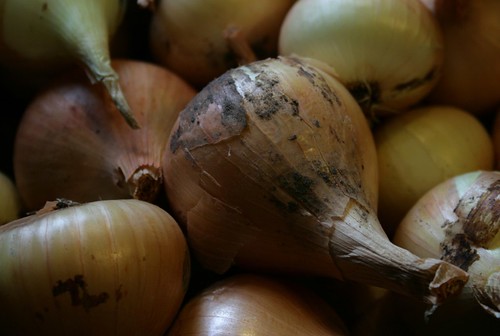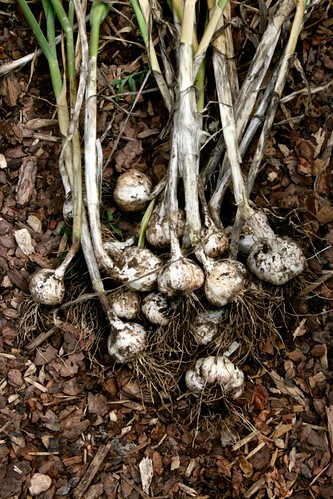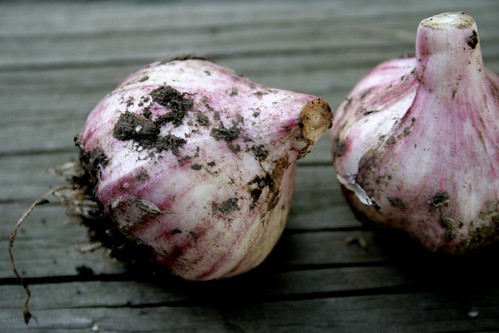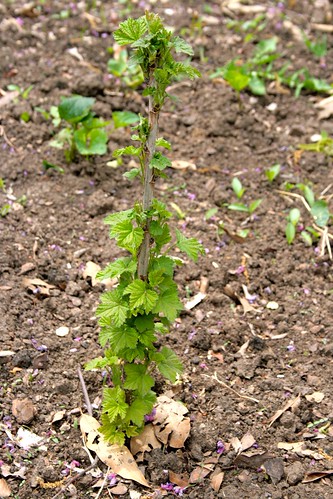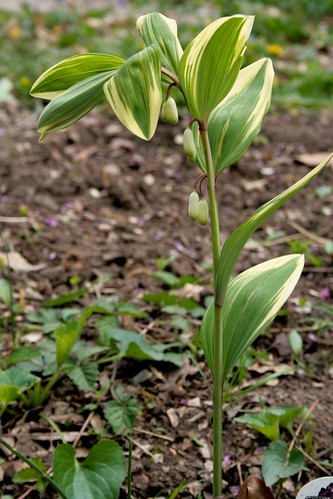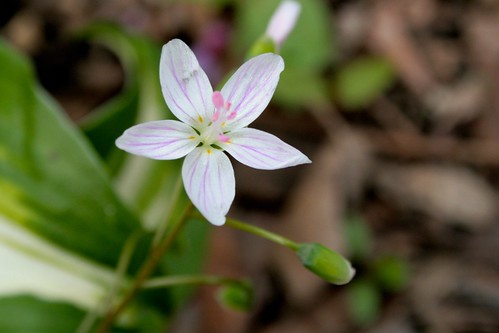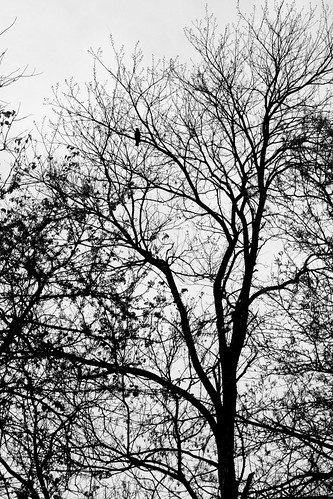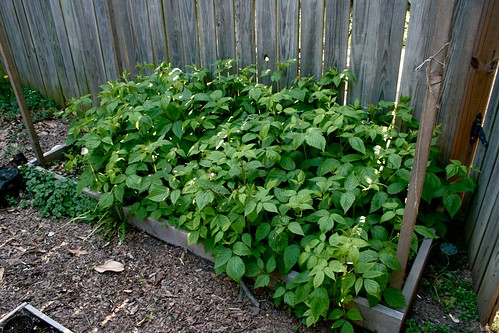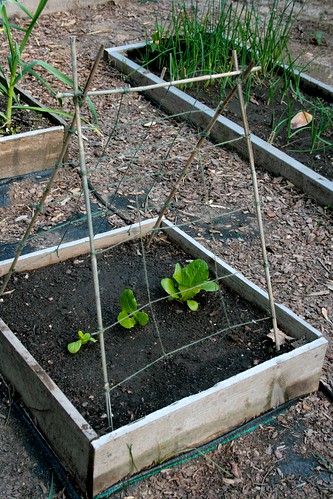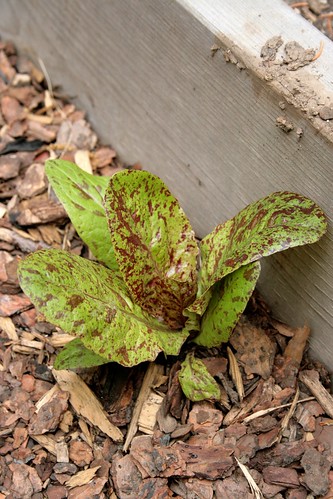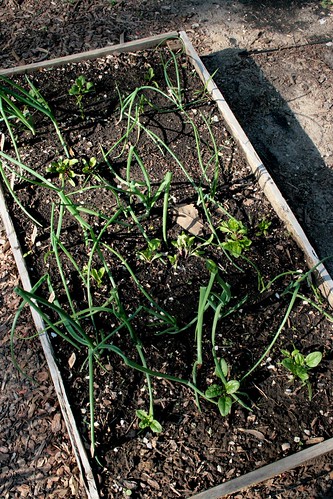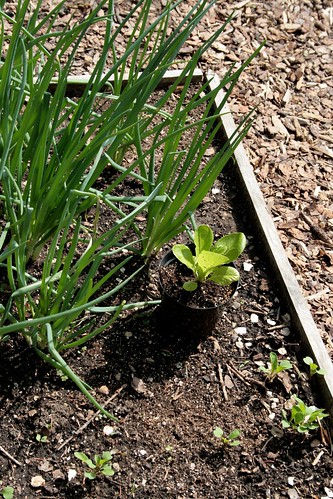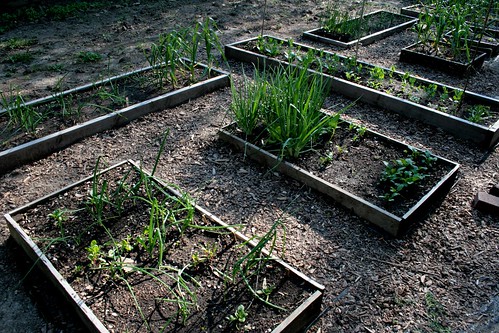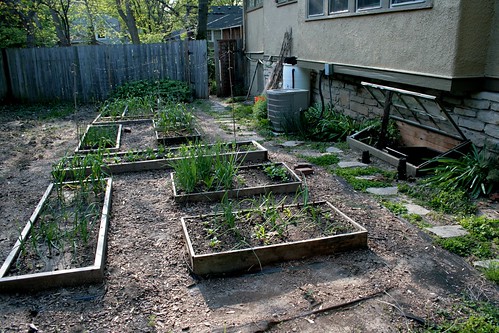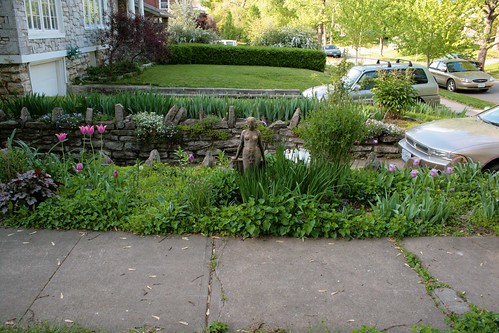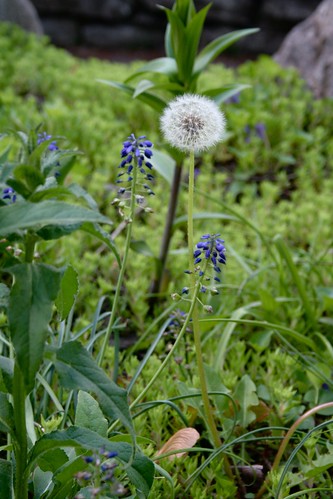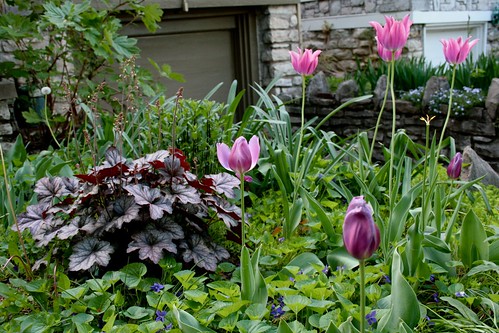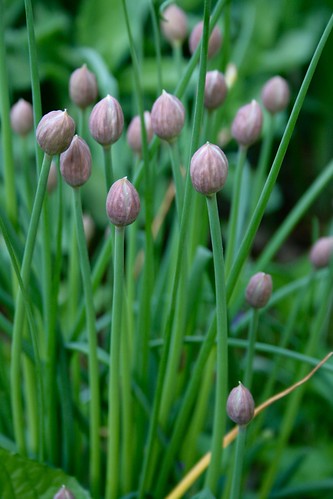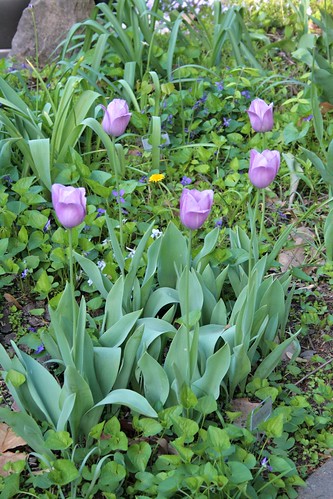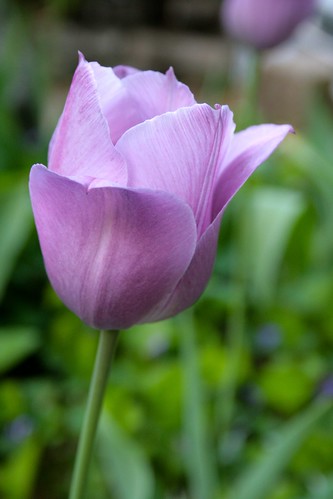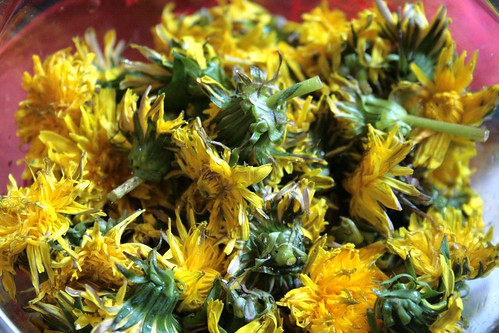Overall, 2010 was perhaps my best year in the vegetable garden. While I still have a ways to go towards self-sufficiency, I completed a couple of big projects and had some decent yields. As with last year, the weather was wet and often predictable, with a mild autumn that extended the season somewhat. I didn't spend much time in my other little gardens, but I did start a woodland garden in the backyard and began the base for my grotto.
The Cold Frame
In February and March, we built a cold frame from an old window cedar 2x4's and installed it just as the soil was beginning to warm.
You can read more about building and installing the cold frame in this entry. In April I was able to put out some seedlings started in the basement, but as soon as the temperature edged towards the 60's and 70's, nearly all of them were fried. First lesson learned. Always keep the lid of your cold frame open when it starts getting warm.
I continued playing with my cold frame through the year, setting seedlings out to begin hardening off and planting seeds inside to see what would grow. In September and October, I planted a hardy lettuce mix and some lettuce seedlings, which I've been closely monitoring since. Even after temperatures began dropping in November and a Thanksgiving snow, the lettuce plants persisted and are still holding up. Admittedly, I am growing cold weather varieties and it's turning out to be a mild winter, but I hardly expected such success.
Relocating the Potager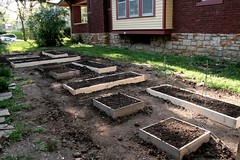
In March and April, we tore down the old vegetable garden and built new frames for the new location on the south side of the house.
I wrote an entry about the process right after we finished. It was a lot of hard work, but it seems to have been worth it. In general, my plants have been stronger and not as leggy, and I've had better yields with larger fruits, especially with the sun-loving plants like bush beans and chile peppers. Because I got a late start transplanting and lost many plants in the cold frame, I was not able to grow as much as I planned, and I ran into many of the same issues with squirrels and insect pests. Nonetheless, I was harvesting cold weather greens into November and digging up parsnips in December, so I'd say it that the new potager is an all-around success.
Growing SuccessesFirst, the new varieties I purchased this year from Territorial and Pinetree...
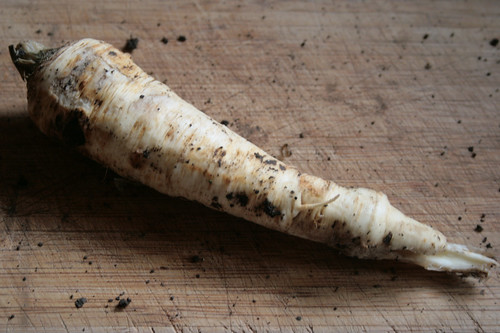
2010 was the first year I grew parsnips, a staple vegetable in Old World cuisine that has largely fallen out of favor, despite some renewed interest in the foodie community. Part of the reason might be that they require a long season to grow to full size and cold weather to fully develop the sugars that give them their distinct flavor. I grew the "Harris Model" parsnip, an open-pollinated variety noted for its flavor and dependability. Before we got a hard frost, I dug up a small root and gave it a taste, only to discover that it was starchy and lacking the pleasant sweetness of a store-bought parsnip. After the ground froze in December, I fought through the hard soil, broke a couple of roots, and was happy to taste the sweet root I had been seeking. Altogether, I yielded 2lb of parsnips, not a lot for a 2'x2' plot of soil, but enough for a couple of meals. The flavor of a fresh parsnip is well worth the time and effort, though.
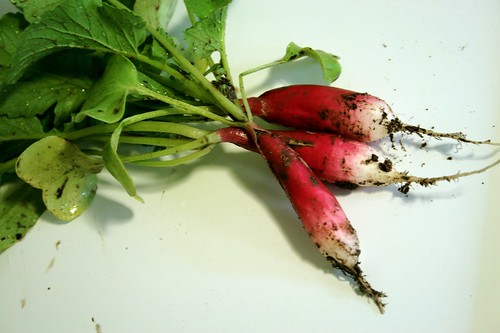
Another plant I grew for the first time was the common radish, which I found fast-growing and unbelievably useful. The heirloom "French Breakfast" cultivar doesn't produce a big meaty radish, but the flavor and texture are distinct, far better than any store-bought variety. I noticed that the flavor of the young radishes was very strong and would be a good addition to salsa. The mature flavor was more delicate and tasty on buttered bread. Much like turnips, the greens of the radish are edible, making them doubly useful in the vegetable garden. Combined with arugula or dandelion greens, they made an excellent spring pesto.
Another successful crop this year was the "Bright Lights" Swiss chard. While I lost the last season's crop to bugs, I was able to harvest a couple of decent sized batches. Chard is one of my favorite vegetables, one I love braised in pasta dishes or folded into a gratin. The "Bright Lights" mix includes a wide range of colors, from yellow to red to green, so it looks just as lovely as it tastes.
In August I ordered a couple of "winter" seed mixes from Territorial, the "Provencal Winter Mix" and "Arctic Tundra Blend." Both were successful, and a few plants started from these mixes are holding up well inside the cold frame. From the Provencal mix, I harvested three French lettuce varieties (Continuity, Salad Bowl, and Brunia), chervil, and lots of endive and roquette (otherwise known as arugula), which I used in several batches of pesto. Territorial does not specify the varieties in the Arctic Tundra blend, but it seems to be a mix of red and green looseleafs. I kept a close watch on the plants as the temperature dropped, and they seemed to survive the nights down to freezing well enough. If you're looking for dependable late season crops and like salad greens, you might want to try these blends.
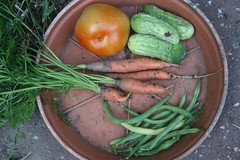
As far as seeds saved from last year are concerned, I had wonderful luck with carrots this year, producing enough for several meals. I really loved the "Mokum" variety I bought from Territorial in 2009, which grows quickly and has a beautiful sweet flavor. I also planted the "Danver's Half-Long," a long season carrot better suited to storage use; the roots were noticeably thicker and took quite at least a month longer for the flavor to develop (even then I didn't find it especially sweet compared to the Mokum).
I also got better yields on the Jade and Gold Crop bush beans I planted, in addition to the black turtle beans I planted late season. This was also the best year I've had for jalapeno peppers. I am not sure if pruning off new leaf growth aided in the higher yields, especially since the bulk of the crop came later than usual. Nonetheless, I had jalapenos coming out of my ears! Herbs were another big success this year, and I had more basil, parsley, dill, and cilantro/coriander than ever.
Semi-SuccessesI was able to harvest a few baby fennel bulbs of the "Perfection" variety. Because my fennel got a late start this year, my expectations were pretty low. Flavor was typical licorice-y fennel flavor. Can't say much about seed flavor/production, as I was growing only for bulbs.
Yields for shelling and snap peas weren't that great either, but I started them at least a month late, so the bushes started to dry up before they hit their peak.
Tomatoes were another disappointment this year. Despite getting a few tomatoes and ending up with plenty of green ones to last through October, most succumbed to squirrel (and possibly bird) attacks during our weekends (and weeks) out of town. I did make an effort to purchase varieties that were new to me, but since I was forced to pick most early, I'm not sure if I got optimal color and flavor. The "Country Taste" hybrid was a solid beefsteak variety with a meaty texture and classic tomato flavor that I would gladly use as my main crop variety. The "Japanese Black Trifele" was an interesting heirloom variety with a flavor that's hard to describe, sort of smokey sweet with a bit of bite. I was already familiar with the "Chocolate Cherry" via our CSA; it's a cherry variety with a flavor similar to "Cherokee Purple." And lastly, while I did not get a chance to taste a really fresh fruit, I did enjoy the "Cuore di Bue" oxheart, which is low in seeds and juice and has a wonderfully tasty acidity that would make a brilliant sauce. Definitely trying this one again.
Another thing I had only middling luck with this year was broccoli. I was able to harvest a few tiny heads and side shoots, and that's about it
FailuresPerhaps the major failure of 2010 was my attempt to grow rhubarb from seed. Based on my reading, it's a notoriously difficult plant to grow from seed, since it is so slow to germinate. Twice I planted the seeds to no avail. Because I am so committed to the idea of growing perennial food plants, this year I'm going to buy some crowns and give it another go. I will have my rhubarb pie!
Otherwise, I cannot seem to grow spinach. I tried three varieties this year--"Giant Noble," "Viroflay," and "Giant Winter"--and had only disappointing results. I can get the seeds to germinate, even grow a few little leaves, but they always end up dying before I get any spinach. Maybe this year I'll have better luck.
Not quite failures but not quite in the realm of success, the squash plants I started this year took off like wild fire but were quickly quelled by infestations of squash bugs and vine borers, which destroyed the fruits and wilted the plants to nothing. In a similar vein, my cabbage and cauliflower transplants grew quite big yet failed to produce anything. My kale, raab, bok choy, and collards also did quite badly. But again, late start, inconsistent use of covers, etc.
Plans for Next Year1. Make better and more consistent use of floating row covers. These are honestly the best technique I've used for keeping cabbage butterflies off my cole crops and, used consistently, eliminate a lot of the headache of picking off caterpillars and spraying aphids. Back in August I researched remedies for squash bugs and vine borers and learned row covers are just as useful for young squash plants, so I'll be testing this out as well.
2. Spend more time in other parts of the yard. Yes, I started my woodland garden in the backyard and added a few more plants to the south border, front border, and rock garden, but overall I neglected various chores and didn't allow myself to enjoy the space surrounding our house. The front border, especially, needs a major overhaul.
3. Keep building the woodland garden. I planted a serviceberry tree, lots of hostas, a Solomon's Seal, and a lily of the valley. This year I am purchasing some currant bushes. Some other plants I'd like to add: wild ginger, jack in the pulpit, monkshood, cyclamen, hellebore, some kind of sedge, and some kind of fern.
4. Finish the grotto. I've been putting off this project for two years now. Except for the mortar, I have every supply necessary. No more excuses.
5. Plant more perennial fruits/vegetables. I've already decided on currant in the woodland garden. Other options include: rhubarb, asparagus, Jerusalem artichokes, Good King Henry, and sorrel. Need more Zone 5B options.
As always, patience. Watch and learn and continue working towards self-sufficiency. 2010 was a pretty good year for gardening. Here's hoping 2011 is even better!
